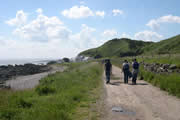Public Rights of Way
 In Scotland, public rights of way (ROWs) may be created through common law by use over a period of time. Conversely they can be lost by non-use. A public right of way can be claimed to exist where the route satisfies all of the following conditions. It must:
In Scotland, public rights of way (ROWs) may be created through common law by use over a period of time. Conversely they can be lost by non-use. A public right of way can be claimed to exist where the route satisfies all of the following conditions. It must:
- connect two public places
- follow a more or less defined route
- have been used by the public as of right
- have been so used without substantial and effective interruption for at least 20 years
Establishing a ROW is not straightforward and in cases of dispute it is the courts who decide if a route meets the requirements for ROW status. Whilst Aberdeenshire Council are statutorily obliged to "assert, protect and keep open and free from obstruction or encroachment any public right of way" (Countryside (Scotland) Act 1967 s.46) the Council must act only if a route meets the necessary conditions and it does not mean that it will investigate the status of every disputed route. Finding evidence likely to be persuasive within the courts can be difficult. The Council is reliant on sufficient evidence being provided by members of the public. Very few cases are actually taken to court and wherever possible are settled though discussion.
If you think a route meets all four criteria above please contact the relevant Access Officer who will be able to give further advice.
Email: outdoor.access@aberdeenshire.gov.uk.
Outdoor Access Officer South (Garioch, Marr and Kincardine and Mearns) telephone: 01467 534333.
Outdoor Access Officer North (Formartine, Buchan, Banff and Buchan) telephone: 01467 534333.
The most comprehensive documentation relating to Rights Of Ways in Scotland is held by the Scottish Rights of Way Society. Aberdeenshire council do not hold or maintain any historic maps of routes in Scotland.
